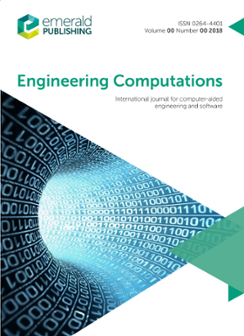Engineering Computations: Volume 3 Issue 3
Strapline:
International journal for computer-aided engineering and softwareTable of contents
Studies of finite element procedures—stress band plots and the evaluation of finite element meshes
Theodore Sussman, Klaus‐Jürgen BatheWe describe a visual method—stress band plots—for displaying the stress solution within a two‐dimensional finite element mesh. The stress band plots differ from conventional…
A secant approximation for holonomic elastic—plastic incremental analysis with a von Mises yield condition
W.W. Bird, J.B. MartinAn algorithm is described for the incremental solution of elastic—plastic finite element analysis using a piecewise holonomic constitutive law based on a von Mises yield…
Design of small and effective finite element systems
Lars‐Erik LindgrenA system consisting of a preprocessor, a finite element program and a postprocessor has been developed. Some features which make preprocessors and postprocessors user‐friendly are…
A profile matrix solver with built‐in constraint facility
Peter Bettess, Jacqueline A. BettessA profile solver which factorizes the profile matrix K into the form LDLT, is described. D is a diagonal matrix and L is a lower triangular matrix. LT is stored by columns, using…
Finite element analyses of secondary flow problems
J.O. Medwell, T.D. Gethin, C. Taylor, J. RanceA method is presented for the determination of secondary flow fields in three practical examples. In one, the flow is laminar and the other two turbulent. The latter were analysed…
Computing angular velocity in multibody systems
Ronald L. HustonThis paper presents algorithms for computing the angular velocities of the bodies of a multibody system. A multibody system is any collection of connected bodies. The focus is…
Numerical experiment with inviscid vortex‐stretched flow around a cranked Delta wing: supersonic speed
Arthur Rizzi, Charles J. PurcellA numerical method that solves the Euler equations for compressible flow is used to study vortex stretching. The particular case simulated is supersonic flow M∞=1.2 α=10 degrees…
Preconditioned conjugate gradient method for the non‐linear finite element analysis with particular reference to 3D reinforced concrete structures
M. Cervera, Y.C. Liu, E. HintonA hierarchically preconditioned conjugate gradient (PCG) method for finite element analysis is presented. Its use is demonstrated for the difficult problem of the non‐linear…
Non‐linear finite element modelling of concrete structures: basic analysis, phenomenological insight, and design implications
Michael D. Kotsovos, Milija N. PavlovićA non‐linear finite element program for concrete structures is outlined, with emphasis on the material modelling. It is shown that the package can be used with confidence in the…
Implicit integration algorithm for elastoplasticity in plane stress analysis
Philippe JetteurAn implicit integration algorithm for elastoplastic constitutive equations in plane stress analysis is presented. The error associated with this algorithm is of the same order as…
Notes on supercomputers
What ia a supercomputer? The term ‘supercomputer’ came into use around 1970 to describe systems which are significantly more powerful than the other machines of their generation…

ISSN:
0264-4401Online date, start – end:
1984Copyright Holder:
Emerald Publishing LimitedOpen Access:
hybridEditor:
- Prof. Chenfeng Li